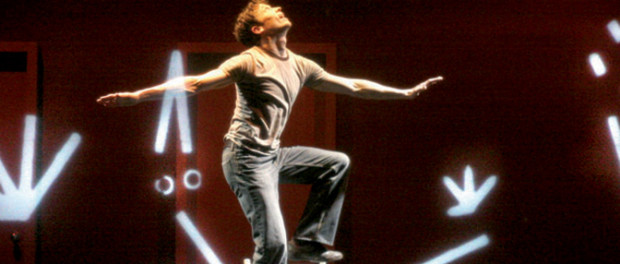Dance and Animation Meet in Norman
“Every film, for me, is a kind of dance, because the most important thing in film is motion and movement. And no matter what it is you’re moving, whether it’s people or objects or drawings or what way it’s done, it’s a form of dance. That’s my way of thinking about film.”
Inspired by this this quote of Norman McLaren’s, Michel Lemieux and Victor Pilon, co-artistic directors of Lemieux Pilon 4D Art, set out to create Norman, a tribute that melded the renowned Canadian animator’s and filmmaker’s legacy with the visual language of the body in 2007. Seven successful years of touring later, the Montreal-based creation returns to its birth city for its final presentations. My view on the subject? Attending the piece is a must, despite a few minor weak points.
The show cleverly bridges documentary and choreography. The premise is that after being exposed to Norman McLaren’s short innovative films, dancer Peter Trosztmer was inspired by their fluid movement in a way he (accurately!) describes as contagious. In a spirited quest to get to the heart of McLaren’s motives, he takes viewers on an exploration of the National Film Board of Canada. A minimalistic yet elegant burnt orange set designed by Anne-Séguin Poirier serves as the perfect backdrop to Trosztmer’s aerobics, and the dialogue allows film excerpts to segueway into archived interviews seamlessly.
Ultimately, Trosztmer’s presence and interpretation of McLaren’s work is that of a fellow viewer, which keeps his character from being too cartoonish. The spellbound audience shares his emotion. Unfortunately, his dancing, though vibrant, simply can’t keep up with the speed of McLaren’s effervescent animation. At times, it feels awkward: the Pas de Deux (1968) sequence of the tribute gives weight to the old saying “Three’s a crowd.”
I sank into my seat a relative neophyte to McLaren’s work. Five minutes into Norman, I was in sensory overload from my first look at the abstract folly of Blinkity Blank (1955). The ambiance in the womblike hall was one of total engrossment. I believe that I speak for the other spectators as well when I say that we were as dreamers, entranced by the multimedia web deftly spun for us by Lemieux and Pilon. Select bits of McLaren’s artistic output were projected for our viewing pleasure, alternating between an ordinary screen, a gauzy curtain, and a more bare-bones holographic projection of characters. Trosztmer’s interactions with the projections were generally well thought-out and entertaining, a pleasant enhancement of their surrealism. The 4D technology was a headily impressive breath of modernism.
This performance left me resoundingly certain of Scottish-born Norman McLaren’s genius. The legacy left behind by the phenomenal Canadian is regrettably little talked about nowadays outside of certain circles; Norman works both as a spectacular introduction for the general public and a treat for those already in the know. I highly recommend the piece to people of most ages, though I think that making its viewing into a family outing might not be ideal given most kids’ hesitant approach towards documentaries and abstract art. On the whole, it’s a true feast for the senses.
Norman. A Tribute to Norman McLaren is at Place des Arts on April 3-5 and 10-12. 8 p.m. $27/34.









